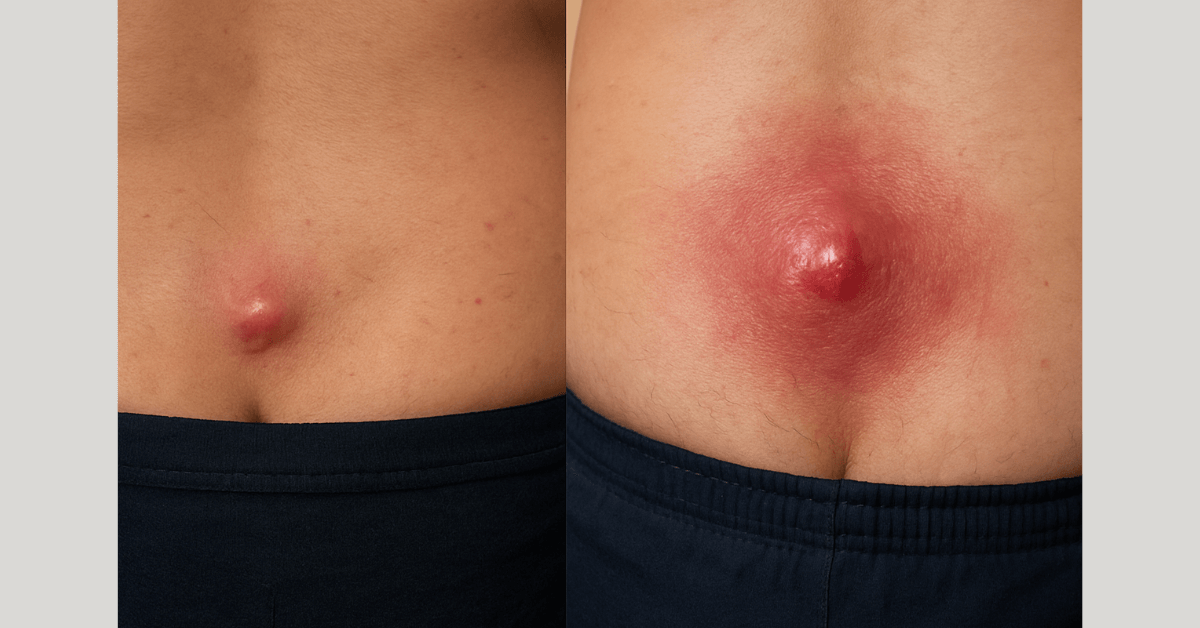Pilonidal cysts are a common condition that can cause considerable discomfort and, in some cases, recurring flare-ups. These cysts often develop at the base of the spine and are characterized by the presence of a hair-filled sac that can become infected. One of the key strategies in managing pilonidal cysts and reducing recurrence is laser hair removal, particularly a method called SiLaC® therapy, which uses advanced laser technology to target and eliminate hair in the affected areas.
In this blog, we will explore the role of laser hair removal in preventing pilonidal cyst recurrence. We’ll also discuss the science behind SiLaC® therapy. Additionally, we will highlight the benefits of integrating this treatment with other management strategies.
What Are Pilonidal Cysts?
Before diving into the role of laser hair removal in preventing pilonidal cyst recurrence, it’s essential to understand what pilonidal cysts are and why they form.
A pilonidal cyst is a small sac-like pocket of tissue that forms at the top of the buttocks, near the tailbone. The cyst can become infected when hair and debris are trapped inside, causing swelling and, sometimes, abscess formation. Pilonidal cysts are most common in young adults and tend to occur in individuals who have thick or coarse hair.
These cysts can be drained and treated surgically. However, preventing recurrence remains a significant challenge. Hair growth often contributes to recurrence.
Laser Hair Removal and Its Role in Preventing Recurrence
Laser hair removal is a non-invasive treatment that uses focused light to target and destroy hair follicles, preventing future hair growth in the treated area. This method has proven effective in treating conditions like pilonidal cysts, where hair growth can contribute to irritation, infection, and the formation of new cysts.
The role of laser hair removal in preventing pilonidal cyst recurrence is twofold:
- It reduces hair in the affected area: By eliminating hair around the tailbone, laser hair removal minimizes the chances of hair getting trapped in the cyst. This helps reduce inflammation and infection.
- It aids in wound healing. Specifically, if a pilonidal cyst has been surgically drained or excised, laser hair removal helps. Additionally, it prevents new hair from growing into the healing wound, thereby reducing the likelihood of new cysts forming.
What is SiLaC® Therapy for Pilonidal Cysts?
SiLaC® (Surgical Laser Treatment for Pilonidal Cysts) uses specialized laser therapy to treat and manage pilonidal cysts. This method targets the hair and tissue around the cyst with a focused laser beam, removing the hair and reducing cyst formation risk.
The advantage of SiLaC® therapy over traditional methods is its non-invasive approach. It treats the cyst without surgery. The laser targets the affected area, shrinking the cyst. It also prevents hair growth, a major contributor to recurrence. Additionally, doctors can use SiLaC® therapy in combination with surgical interventions to provide long-lasting relief.
How Does Laser Hair Removal Work for Pilonidal Cysts?
Laser hair removal uses a highly concentrated beam of light to target hair follicles. The light is absorbed by the pigment (melanin) in the hair, which is then converted into heat. This heat destroys the hair follicle, preventing future hair growth.
When applied to pilonidal cysts, laser hair removal works by:
- Reducing the number of hair follicles in the affected area, making it less likely for hair to become trapped in the cyst and cause an infection.
- Decreasing inflammation: By eliminating the hair, there is less friction and irritation in the area, which can help reduce the risk of future flare-ups and cyst formation.
- Preventing recurrence: After surgically treating or draining a pilonidal cyst, laser hair removal prevents new cysts by targeting hair regrowth and eliminating the root cause of recurrence.
Why Is Laser Hair Removal Important for Managing Pilonidal Cysts?
Hair growth plays a significant role in pilonidal cyst recurrence. Hair can contribute to the development of cysts by becoming trapped in the skin and causing inflammation. Additionally, even after surgery, new hair growth in the affected area can exacerbate the problem and lead to the formation of new cysts.
Here are a few reasons why laser hair removal is crucial for managing pilonidal cysts:
1. Minimizes the Need for Surgical Intervention
While surgery is effective for treating pilonidal cysts, laser hair removal can help prevent recurrence. This reduces the need for repeated surgeries.
2. Reduces Inflammation and Infection
By eliminating hair and minimizing the irritation caused by hair regrowth, laser hair removal reduces the chances of developing painful, infected cysts that require medical attention.
3. Non-Invasive and Convenient
Unlike traditional surgical procedures, laser hair removal is non-invasive and typically requires no recovery time. Patients can return to their normal activities immediately after the treatment, making it a convenient option for long-term management.
How Effective Is SiLaC® Laser Therapy for Pilonidal Cysts?
SiLaC® laser therapy is one of the most effective treatments for pilonidal cysts. It is especially beneficial for patients with recurrent cysts. Additionally, it offers a non-invasive option for those who wish to avoid surgery. Here’s why SiLaC® works:
- Long-Term Results: Unlike temporary treatments such as antibiotics or drainage, SiLaC® provides long-term relief by addressing the root cause of cyst formation—hair regrowth.
- Reduction of Recurrence: Studies have shown that patients who undergo SiLaC® therapy have a significantly lower recurrence rate compared to those who rely on surgery alone.
- Quick and Effective: The laser treatment targets only the hair follicles, meaning it doesn’t damage surrounding tissue and allows for a faster recovery.
Prevention of Pilonidal Cyst Recurrence
One of the most challenging aspects of pilonidal cyst treatment is preventing recurrence. Many patients experience multiple flare-ups, even after undergoing surgery. Laser hair removal, particularly SiLaC® therapy, offers a proactive way to prevent future cysts from forming by targeting the underlying cause—hair in the area.
Preventative measures include:
- Regular laser hair removal treatments: Ongoing treatments can prevent hair from regrowing in the affected area, reducing the risk of cyst recurrence.
- Good hygiene practices: Keeping the affected area clean and free from excess moisture can also help prevent the cysts from reforming.
- Lifestyle changes: Maintaining a healthy weight and avoiding prolonged sitting can reduce the pressure on the tailbone, which can exacerbate pilonidal cysts.
What to Expect During and After Laser Hair Removal Treatment
The SiLaC® procedure and standard laser hair removal treatments are relatively straightforward and involve minimal discomfort. Here’s what you can expect:
During Treatment:
- The treatment area will be cleaned and, in some cases, numbed with a topical anesthetic.
- A laser device will be used to target the hair follicles. Each pulse of the laser targets a hair follicle, which may cause a slight tingling or snapping sensation.
- The procedure typically lasts between 15 and 30 minutes, depending on the size of the treatment area.
After Treatment:
- Some mild redness or swelling may occur in the treated area, but this usually subsides within a few hours.
- Patients can return to normal activities immediately after treatment, although it’s advisable to avoid hot showers or strenuous exercise for a day or two.
Conclusion: A Comprehensive Approach to Pilonidal Cyst Management
Laser hair removal, particularly SiLaC® therapy, offers an effective, non-invasive solution for preventing and managing pilonidal cysts. By addressing the role of hair growth in cyst formation, laser hair removal helps to reduce recurrence and improve long-term outcomes.
Whether you’ve had a pilonidal cyst once or multiple times, SiLaC® therapy at IBI Clinic offers lasting relief. It can help prevent future flare-ups. Contact us today to learn more and take the first step toward better management of your pilonidal cysts.



